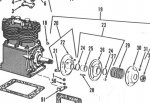3rdmdqm
Active member
- 430
- 102
- 43
- Location
- Woodbine Maryland
When the air copressor is not running, the belts are tight and rotate normally/smooth. When the air compressor kicks on, the belt that drives the compressor starts jumping around as if it is loose. It doesn't jump off the pulley or anything, the belts flex and jump in the center between the pulleys. The compressor works fine, I've just never seen a belt jump around like that before. The belt is on tight, so I don't think that's the issue. Anyone seen this before or have any ideas? 



